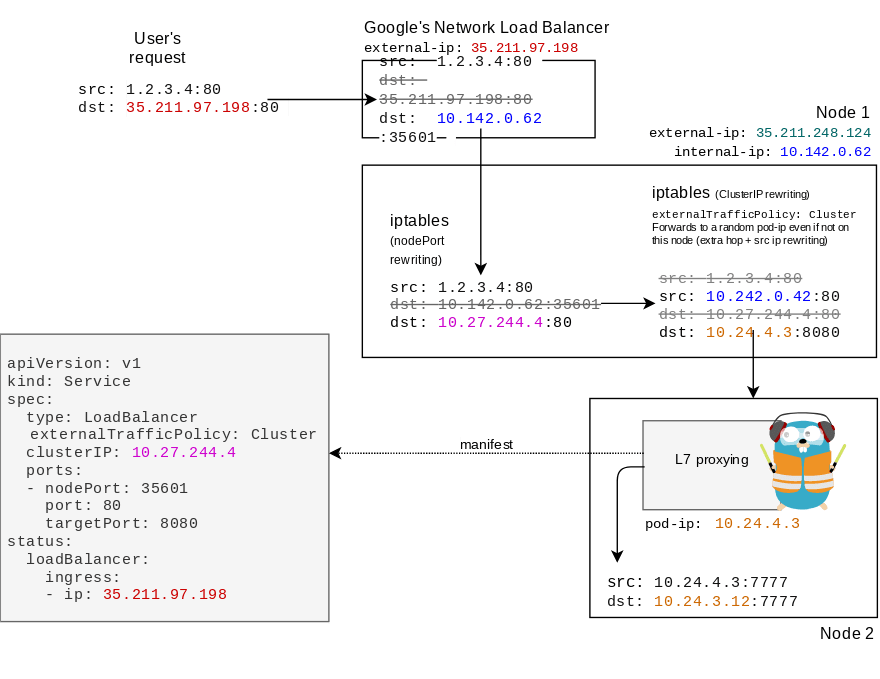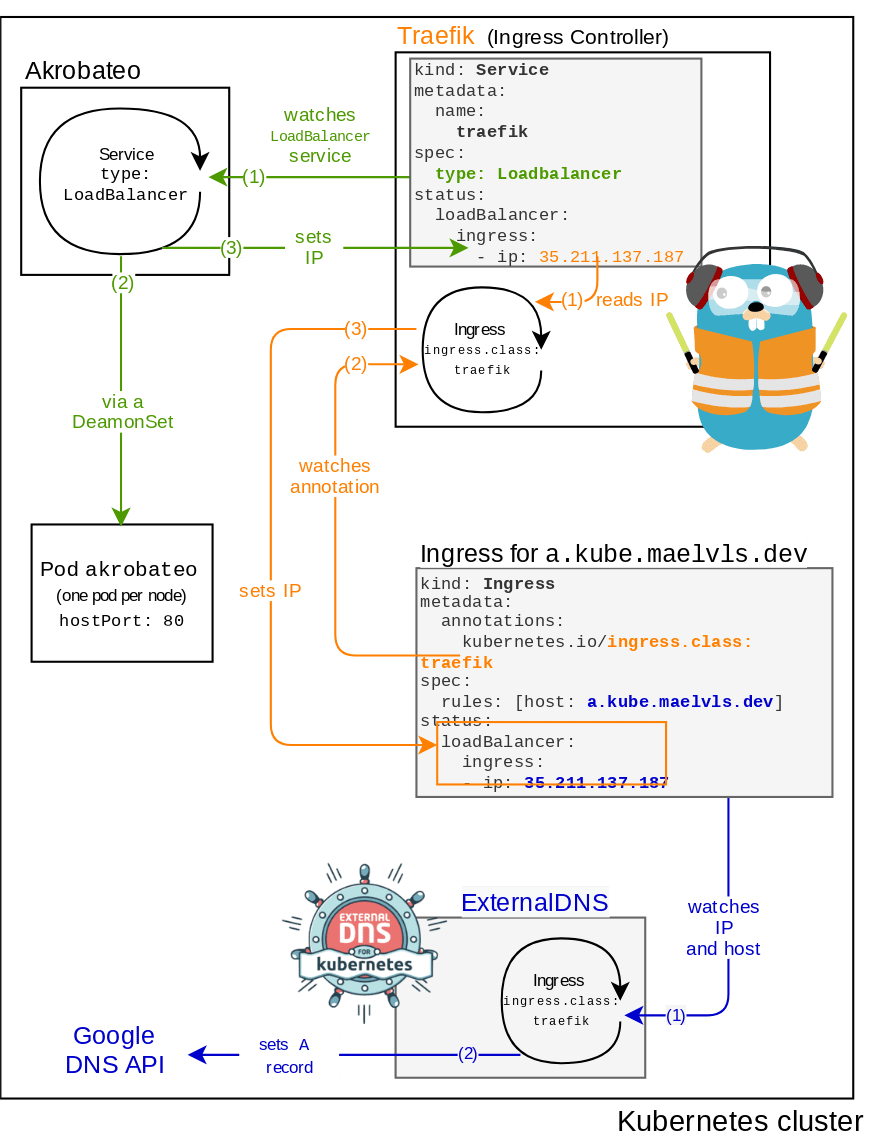The Service and Ingress respectively brings L4 and L7 traffics to your pods. I previously talked about using hostPort to avoid GKE's load balancer without really getting into the details of how everything works. In this article, I focus on how traffic flows in and what are the interactions between the ingress controller and the "service-lb controller" (the thing that creates the external load balancer). I also detail how the hostPort approach shapes traffic.
In Kubernetes, the service object represents how a set of pods can be hit with TCP or UDP connections. Since it is L4-only, the service only deals with IPs and ports. An Ingress is the L7 counterpart of a service: it deals with TLS, hostnames, HTTP paths and virtual servers (called "backends").
Note: you might see some mentions of ingresses since Traefik is an ingress controller but I will not describe the traffic handling at the L7 level.
An ingress controller is a binary running as a simple deployment that watches all Ingress objects and live-updates the L7 proxy. Traefik qualifies as an ingress controllers: it has the nice property of embeding both the "ingress watcher" and the L7 proxy in a single binary. HAProxy and Nginx both use separate ingress controllers. And in order to get L4 traffic coming to the L7 proxy, we usually use a service that has the type LoadBalancer.
I call "service-lb controller" a binary that watches service objects that have the LoadBalancer type. Any time the Google's service-lb controller sees a new LoadBalancer service, it spins up a Network Load Balancer and sets up some firewall rules. In fact, Google's service-lb controller runs as a small closed-source binary that runs on your master node (but not visible as a pod) and acts as a service-lb controller.
Here is a diagram that represents how GKE's service-lb controller interacts with the ingress controller:
So, how does external traffic make it to the pod? The following diagram shows how a packet is forwarded to the right pod. Notice how many iptable rewriting happen (which corresponds to one connection managed by conntrack):
Now, let's see how it goes when using Akrobateo (I detailed that here). Instead of using an external compute resource, we use the node's IP in order to let traffic in.
Note: Akrobateo is EOL, but K3s's servicelb and Metallb work in a very similar way, setting the service's status.loadBalancer field with the correct external IP.
You might wonder why the 'internal IP' is used in status.loadBalancer. We might expect the external IP to be set there. But since Google's VPC NAT swaps the node's external IP to the node's internal IP, the incoming packets have the internal IP as source IP. So that's why 😁.
The following diagram shows a packet coming from a user being routed to the Service that has the ClusterIP 10.24.3.12. Notice the number of packet rewritings:
- DNAT by the VPC firewall,
- DNAT in the
hostPortrule on node 1, - DNAT in the Akrobateo pod,
- DNAT for the Service ClusterIP rule on node 1,
- SNAT due to the
externalTrafficPolicy: Clusterrule on node 1 (service-level random load-balancing across nodes), - User-space TCP termination by Traefik (i.e., new dial to the pod-ip).
That's a lot of hops and rewritings!
src="https://maelvls.dev/packets-eye-kubernetes-service/kubernetes-traffic-with-akrobateo.svg" width="70%"/>
Update 28 April 2020: Fixed a mistake I made in this diagram. I had set the source port to 80 in the "User's request". This example does not reflect what happens in reality. When connecting to a remote host, the TCP stack picks a random ephemeral IP above or equal 32768. The kernel calls it "local ports", see
inet_hash_connect(inet_hashtables.c),secure_ipv4_port_ephemeral(secure_seq.c) andip_local_port_range(ip-sysctl.txt).So I changed the "User's request" source port from 80 to 32345:
-src: 1.2.3.4:80 +src: 1.2.3.4:32345 dst: 35.211.248.124:80
With the "Akrobateo" method, we only rely on the VPC's firewall rules. But using the node's IP is not perfect: it might be a seen as a security risk, and the many IPs that end up in the service's status.loadBalancer isn't ideal when it comes to setting your DNS A records:
- when a node disappears, the DNS might forward traffic to a unexisting node,
- offloading ingress traffic load balancing from a load balancer with a single IP to relying on DNS records isn't ideal since DNS records leave you very few options as to how to balance traffic.
K3s uses this approach of using the node IPs as service backends and does not need any external load balancer.
Update 28 April 2020: fixed an error with the source port in the last diagram. Added the list of DNAT and SNAT rewritings that happen in the last diagram. I also rewrote the introduction.










Latest comments (1)
Great read! Just want to let you know that the images aren't loading on Dev.to but they're working well on your website :)